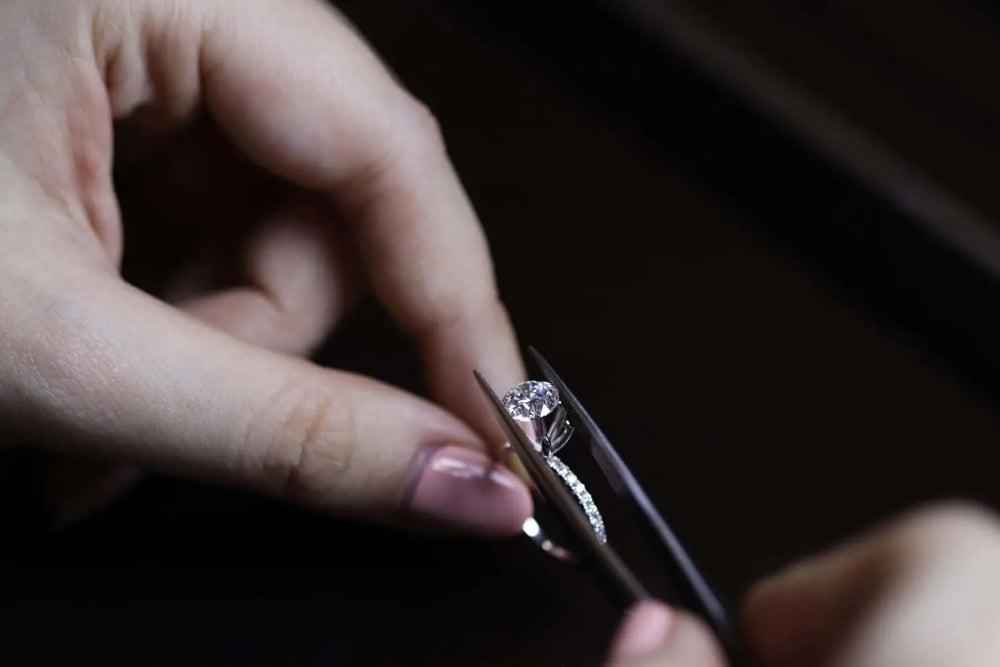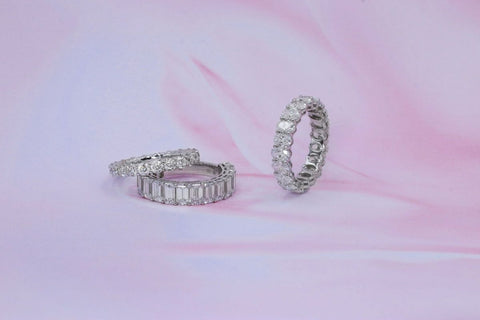Lab Grown Diamonds: What You Need To Know

Table Of Content
Discovered billions of years ago, the diamond has left generations bewitched with its intense glow and label of luxury and exclusivity. As the saying “Diamonds Are A Girl’s Best Friend” goes, the allure and value assigned to diamonds continues to persist.
Today, the market for Lab-Grown Diamonds is blossoming, with many shifting their preference from naturally mined diamonds to this lab-created alternative. This is attributed to the growing perception of lab-grown diamonds as generally more affordable, ethical and conflict-free in comparison to natural diamonds.
This article addresses some frequently asked questions pertaining to lab-grown diamonds and specifically, what to look out for when purchasing fine jewelry made with lab-grown diamonds.
What Are Lab Grown Diamonds?
Lab-Grown Diamonds are essentially real diamonds that are man-made in a lab environment. They are created using technology that is capable of replicating the formulation process of natural diamonds which are formed in the earth’s crust. Lab grown diamonds possess chemical and physical properties that are identical to the natural diamond. It often takes an experienced gemologist to discern between the two. When tested with a diamond tester, both natural and lab grown diamonds display the same positive results.
Two common techniques employed to create lab grown diamonds are: High Pressure High Temperature (HPHT) and Chemical Vapour Deposition (CVD). These processes yield the same results within a few weeks.
What Makes Lab Grown Diamonds Unique?
They are a sustainable and conflict-free alternative that retain the excellent qualities and unrivalled allure possessed by natural diamonds.
In recent years, natural diamond alternatives including Precious Coloured Gemstones (ie. Sapphire, Ruby and Emerald) and Moissanite have garnered immense attention, with Lab Grown Diamonds emerging as one of the most popular choices. The jewelry industry has seen major diamond producers such as De Beers adding lab grown diamonds to their portfolio, recognising the growing worldwide demand and prospects for these stones which is further projected to expand over the next few years.
The key difference that separates lab grown diamonds from natural diamonds lies in its origin, which directly affects the diamond formation process and consequently the environment. Unlike natural diamonds which are retrieved by the means of mining, lab grown diamonds are created in a lab environment.
Lab grown diamonds replicate the notion of “A diamond is forever” in terms of its quality that is equivalent to that of a natural diamond. The sparkle and lustre of a lab grown diamond do not falter, they do not exhibit traces of dulling or lose their shine over time.
In addition, as lab grown diamonds are composed of 100% carbon, alike the natural diamond, they remain as the hardest gemstone with a score of 10/10 on the Mohs Hardness Scale. Being highly durable, it is extremely rare that they will suffer scratches or breakages.
In terms of pricing and resale value, the price of a lab-grown diamond is estimated to be about 40-50% of the price of the natural diamond, making them a more affordable option. However, they currently hold little to no resale value in contrast to natural diamonds.
(Photo Credit: LeCaine Gems; featuring Round, Emerald & Oval Lab Grown Diamonds)
What To Know Before Purchasing A Lab Grown Diamond?
The Fundamental 4Cs: Cut, Clarity, Colour and Carat
The 4Cs are the key assessment criteria when selecting a natural diamond or a lab grown diamond, as it directly affects the stone’s quality and resale value.
Cut: A variety of cuts and shapes exists, including Round Brilliant and Fancy Cuts such as Cushion, Princess, Oval, Marquise and Emerald. The shape of a natural diamond is determined by its inherent structure formed naturally, which is cut and polished accordingly to maximise its sparkle. Lab grown diamonds on the other hand are subjected to fewer constraints and thus able to accommodate greater versatility.
Clarity: With a high refractive index of 2.41, diamonds exhibit an intense sparkle and brilliance. Some diamonds contain natural inclusions that occur during the diamond creation process. The presence of inclusions affects the diamond’s clarity grade as it impedes the penetration and reflection of light. Diamonds that are ‘Flawless (FL)’, ‘Internally Flawless (IFL)’ are more brilliant than ‘Very Very Slightly Included (VVS)’ grades, and tend to command higher prices. However, inclusions in VVS diamonds are minor and difficult to spot with the naked eye.
Colour: Lab grown diamonds adhere to the same grading system as natural diamonds, following an alphabetical order to determine whether it is colourless. Grades ‘D’, ‘E’, ‘F’ are colourless and more similar to white diamonds, making them more valuable. Grades ‘G’, ‘H’, ‘I’ and ‘J’ exhibit colours that are slightly yellow.
At LeCaine Gems, our lab grown diamonds are available in grades ‘D’, ‘E’ and ‘F’.
Carat: The carat size of a diamond directly affects its price. As natural diamonds are more valuable and expensive than lab grown diamonds, one can obtain a lab grown diamond of a larger carat size than a natural diamond at the same price.
Certification and Trusted Jeweler
Be it a lab-grown or natural diamond, it is important to obtain grading and certification to guarantee the diamond’s quality and authenticity. Beyond that, approach a trusted jeweler for advice on selecting a diamond based on your jewelry preferences and budget. If you are hoping to purchase a lab-grown diamond as a stone for a ring, you may wish to approach a jeweler that provides a ring setting service.
At LeCaine Gems, our diamonds which are certified by the International Gemological Institute (IGI), are a representation of our Promise of Everlasting. In sourcing natural diamonds and creating lab grown diamonds, we adhere to our priority of delivering only sustainable and conflict-free gems and jewelry. With manufacturing offices in Hong Kong and Japan, excellent craftsmanship is used to incorporate these diamonds with precious metals to create exquisite fine jewelry. Each jewelry piece is unique, and no two pieces are the same. Our lab-grown diamond collection features fine jewelry and bridal jewelry, including lab-grown diamond engagement rings, lab-grown diamond wedding rings and Si Dian Jin with lab-grown diamonds.
(Photo Credit: LeCaine Gems; featuring Eternity Bands with Round, Emerald & Oval Lab Grown Diamonds)
Design and Budget
When choosing a lab-grown diamond jewelry, have a design and budget in mind. From the gemstone Cut and Shape, to the type of Shanks and Settings, this enables you to narrow down a product range or design your own jewelry.
Based in Singapore, LeCaine Gems specializes in our Bespoke Jewelry Experience, where we work with customers to design and create their ideal jewelry according to their desired budget and style. With an extensive portfolio encompassing Natural Diamonds, Lab-grown diamonds, Precious Gemstones and Moissanite, you get to choose the gems that accommodate your preferences. Our Bespoke Gallery and Inspiration offers you a preview of several custom-made designed jewelry we have created with our valued customers. Our prices for lab-grown diamonds include a simple band setting to accompany the stone. For more information on pricing and our Bespoke Jewelry Service, contact us here or simply send us a message on Whatsapp via +65 8363 3168.
Want to know the difference between two popular diamond alternatives? Check out our article on Lab Grown Diamonds VS Moissanite.
 Skip to main content
Skip to main content



